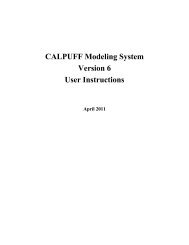Volume 1 - The Atmospheric Studies Group at TRC
Volume 1 - The Atmospheric Studies Group at TRC
Volume 1 - The Atmospheric Studies Group at TRC
Create successful ePaper yourself
Turn your PDF publications into a flip-book with our unique Google optimized e-Paper software.
Anemometer Height Adjustment for Layer 1<br />
An adjustment to near-surface measured wind speeds is applied to estim<strong>at</strong>e the speed<br />
<strong>at</strong> the mid-point height of Layer 1 (usually 10m above the surface). Previously, such<br />
an adjustment must be accomplished outside of the CALMET/CALPUFF system.<br />
Anemometer heights are provided for all surface wind st<strong>at</strong>ions used in an applic<strong>at</strong>ion,<br />
so similarity theory, or even a simple power law adjustment, can be used to make the<br />
adjustment.<br />
CALMET supports an option to scale the near-surface measured winds to other<br />
layers aloft using either similarity theory, a stability-dependent power law, or a usersupplied<br />
set of multipliers (one for each layer). <strong>The</strong> same option has been<br />
implemented for adjusting the observed surface d<strong>at</strong>a to a height of 10 m, for Layer 1.<br />
In addition, if no extrapol<strong>at</strong>ion to layers aloft is selected, a neutral logarithmic wind<br />
profile is applied to estim<strong>at</strong>e the wind speed <strong>at</strong> 10m from th<strong>at</strong> measured <strong>at</strong><br />
anemometer height.<br />
Wind speed extrapol<strong>at</strong>ion is controlled by variable IEXTRP. For layer 1, the<br />
following options are available:<br />
1 extrapol<strong>at</strong>e vertically using a logarithmic wind<br />
profile<br />
IEXTRP =<br />
2 extrapol<strong>at</strong>e vertically using a power law equ<strong>at</strong>ion<br />
3 extrapol<strong>at</strong>e vertically using user-defined scaling factors<br />
4 extrapol<strong>at</strong>e vertically using similarity theory<br />
If z m is the anemometer height (m) of the surface wind observ<strong>at</strong>ion and u m is the<br />
measured wind speed (m/s), the extrapol<strong>at</strong>ion equ<strong>at</strong>ion options are:<br />
1:<br />
u<br />
( 10)<br />
( z0<br />
)<br />
( z z )<br />
ln 10<br />
= um (3-30)<br />
ln<br />
m<br />
0<br />
( 10) ( / )<br />
P<br />
2 : u = um 10 zm<br />
(3-31)<br />
3 :<br />
u<br />
( 10) FEXTRP( 1)<br />
= um<br />
(3-32)<br />
Final Report Vol.1 13







